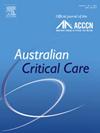Long-term outcomes following a rapid response team attendance
IF 2.7
3区 医学
Q2 CRITICAL CARE MEDICINE
引用次数: 0
Abstract
Objective
The aim of this study was to describe the long-term results of patients needing a rapid response team (RRT) call at a university-affiliated Australian hospital that accepts quaternary referrals.
Methods
An observational study to evaluate the database of RRT for inpatients aged ≥16 years was linked to a population registry of deaths (July 2013–July 2021). Outcomes were 96-month cumulative survival, RRT call, hospital and posthospital (the period beyond hospital stay associated with RRT call) mortality, and trend over time.
Results
There were 31 447 calls to 17 349 inpatients, of whom 9274 (53.5%) were males, with a median age of 72 (interquartile range: 57–83) years. At the 96-month census point, 9317 (53.7%) patients were alive. Of the 8032 who died, 204 (2.5%) died at RRT call, 2262 (28.1%) at hospital discharge, and 5570 (69.3%) died following hospital discharge. A total of 5470 (68.1%) patients had died within 12 months of RRT call. Compared with general population deaths, RRT patients died younger (median age: 79 vs 88 years), were more likely to die in a hospital (54.6% vs 41.7%), and were less likely to die in a private location (11.9% vs 18.8%).
Discussion
Survival duration varied by RRT trigger, with the least duration observed for cardiac arrest, followed by oxygen desaturation and tachypnoea. Lesser survival duration was also observed for male patients, medical admissions, patients with multiple calls, and those with a not-for-resuscitation order. Mortality decreased over the study period, whilst the RRT dose increased.
Conclusions
Most deaths occur within 12 months of an index RRT call and following hospital discharge. RRT patients die at a younger age than the general population. Cumulative survival varied by RRT trigger and improved over time.
快速反应小组出席后的长期结果
目的:本研究的目的是描述在澳大利亚一所大学附属医院接受四级转诊的患者需要快速反应小组(RRT)呼叫的长期结果。方法一项评估≥16岁住院患者RRT数据库的观察性研究与人口死亡登记(2013年7月- 2021年7月)相关联。结果是96个月的累积生存、RRT呼叫、住院和出院后(与RRT呼叫相关的住院时间以外的时间)死亡率以及随时间的趋势。结果17 349例住院患者共就诊31 447次,其中男性9274例(53.5%),年龄中位数为72岁(四分位数间距为57 ~ 83)。在96个月的人口普查点,9317例(53.7%)患者存活。8032例死亡中,204例(2.5%)在RRT呼叫时死亡,2262例(28.1%)在出院时死亡,5570例(69.3%)在出院后死亡。共有5470例(68.1%)患者在RRT呼叫后的12个月内死亡。与一般人群死亡相比,RRT患者死亡更年轻(中位年龄:79岁对88岁),更有可能在医院死亡(54.6%对41.7%),更不可能在私人场所死亡(11.9%对18.8%)。生存时间因RRT触发而异,心脏骤停持续时间最短,其次是氧饱和度降低和呼吸急促。男性患者、住院患者、多次就诊患者和不要求复苏的患者的生存时间也较短。在研究期间死亡率下降,而RRT剂量增加。结论:大多数死亡发生在RRT呼叫后12个月内和出院后。RRT患者的死亡年龄比一般人群要小。累积生存因RRT触发而异,并随时间而改善。
本文章由计算机程序翻译,如有差异,请以英文原文为准。
求助全文
约1分钟内获得全文
求助全文
来源期刊

Australian Critical Care
NURSING-NURSING
CiteScore
4.90
自引率
9.10%
发文量
148
审稿时长
>12 weeks
期刊介绍:
Australian Critical Care is the official journal of the Australian College of Critical Care Nurses (ACCCN). It is a bi-monthly peer-reviewed journal, providing clinically relevant research, reviews and articles of interest to the critical care community. Australian Critical Care publishes peer-reviewed scholarly papers that report research findings, research-based reviews, discussion papers and commentaries which are of interest to an international readership of critical care practitioners, educators, administrators and researchers. Interprofessional articles are welcomed.
 求助内容:
求助内容: 应助结果提醒方式:
应助结果提醒方式:


